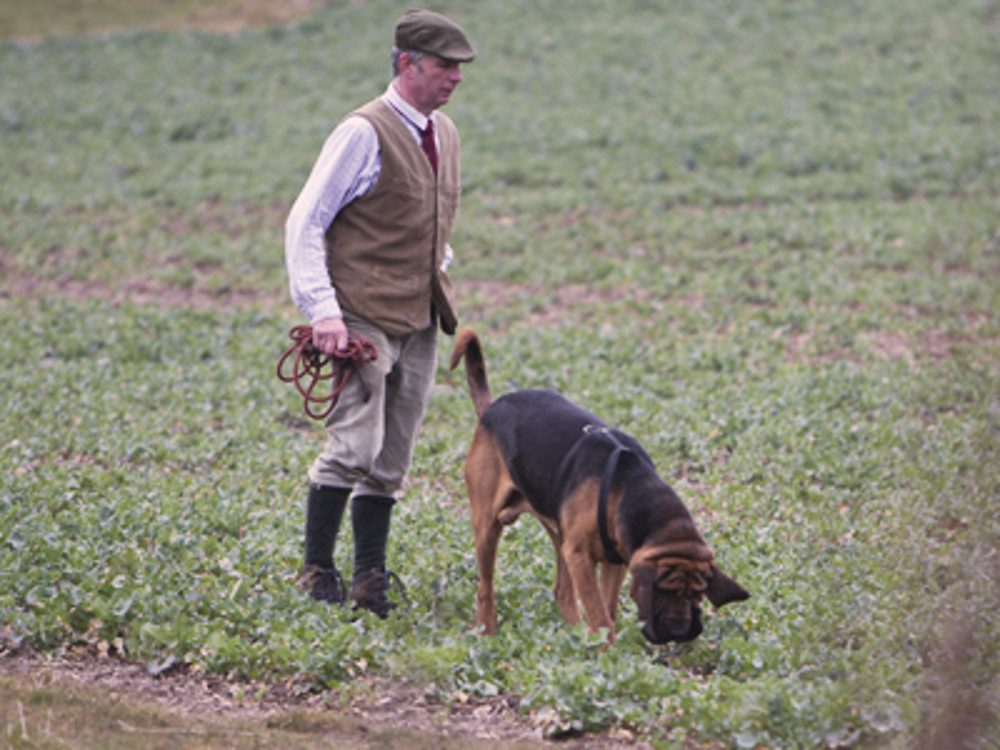
Once you have started training your hound and understand more about what is involved, you may feel ready to start competing in your first Bloodhound working trial.
Be aware that trials span several days. After you have entered you will be sent details of the meeting place and your reporting time (which is decided by a draw). As the competitors and judging teams usually move in convoy from line to line, you may need to arrive well ahead of your start time. Any hound which is not present at least an hour before its published start time may be disqualified by the judge.
Only one person may handle a hound during a trial. Punitive correction or harsh handling is forbidden, and hounds may not be withdrawn without first notifying the stake manager.
Once you are ready to begin competing in bloodhound working trials, the first step is to fill out an entry form from a schedule.
Find out more about both of these below.
Schedule
A schedule is a small booklet of information detailing the trial’s information and includes the entry form. It will list all the classes available and the judges who are judging the various stakes, the secretary and trial manager's information, the class definitions, the venue address and much more. These can be obtained free of charge from the secretary of both Bloodhound clubs.
Entry form
To enter a competition, you will need to find your way to the right part of the schedule, which has the entry form. From there you will need to select which stake you are eligible to enter. The schedule will always offer detailed definitions of each stake.
Signing the entry form is important as it forms the contract between yourself and the society. If the dog is jointly owned, both owners should sign the entry form unless one of the parties has the written permission of the other to sign on their behalf. By signing, you are declaring that your dog is fit and healthy to take part in the trial, and that you will abide by The Kennel Club's rules and regulations.
Before you attend your first trial
There are a number of things you should remember to do before you attend the trial.
Checklist of things to do
- Handlers generally wear light-coloured tops
- Dress appropriately. You should wear plenty of layers of warm clothing, strong waterproof walking boots or wellies. Make sure that you also have windproof and waterproof jackets, and that your clothing blends in with the countryside. However, it is conventional for the handler of a competing hound to wear a white or light-coloured top to make them more visible
- With the vagaries of the British weather you are well advised to take a change of clothing with you, so that you are not faced with a cold and damp car journey home. Also pack food and drink for yourself, as you will not be near any shops. Judges' lunches are provided by the hosting society
- Bloodhound working trials usually mean a long car journey, so think about your dog's needs too - a good strong travelling cage and plenty of water will make their trip comfortable. Often working dogs are not fed before a day's work but you should remember to pack your dog's bowls and some food as you may not return home from the trial until late in the evening
- Although the schedule/catalogue will tell you where the trial is going to take place you should also take with you the recommended ordinance survey map for the area. The meet for the trials is advertised in the catalogue with O/S map reference numbers; it could be a different meet for each stake or it could be a nearby village pub
Things to take to the trial
- Water bowl and water
- Food for yourself and your dog
- Waterproof clothing
- Clothes for the day
- Money
- Proof of posting (if you posted your entry) or a printed copy of the confirmation email received from the online entry that was made
What to expect at the trial
When you arrive at the trial, you'll be immersed into a whole new world, surrounded by Bloodhound trialing enthusiasts.
What should I do while at the trial?
- At your first Bloodhound working trial, your hound may behave differently than during training. In particular your hound can be bothered by crowds or travelling in a convoy. If this is the case, you can move away from other competitors, which can help to settle your hound - but do not lose sight of the convoy
- Bloodhounds should be kept under good control at all times, both whilst waiting to compete and during the trial. You should always be aware of how your hound is reacting and what it is doing. If it does misbehave, you should never handle your hound harshly, or use punitive correction. All Bloodhounds should be trained and worked using plenty of encouragement
- If for any reason you become aware that your hound is not working well, you should ask the judge's permission to withdraw, and for the sake of the hound ask the route of the line so that the hound can be walked in and meet up with his runner. His reward is finding his runner
Next step - competing in Bloodhound working trials
Once you have attended your first trial, next is becoming a competitor. Learn more about competing in Bloodbound working trials.
